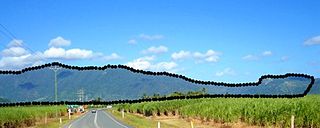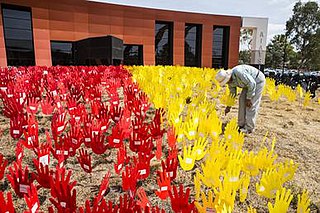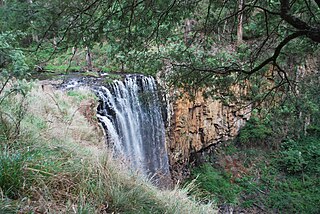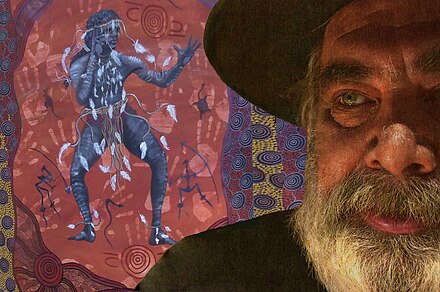
The platypus, sometimes referred to as the duck-billed platypus, is a semiaquatic egg-laying mammal endemic to eastern Australia, including Tasmania. The platypus is the sole living representative of its family (Ornithorhynchidae) and genus (Ornithorhynchus), though a number of related species appear in the fossil record.

Australian Aboriginal religion and mythology is the sacred spirituality represented in the stories performed by Aboriginal Australians within each of the language groups across Australia in their ceremonies. Aboriginal spirituality includes the Dreamtime, songlines, and Aboriginal oral literature.

Eungella is an Australian township nestled on the edge of the Clarke Range at the end of the Pioneer Valley 80 km west of Mackay, and 858 km northwest of Brisbane. Eungella is noted for the national park which surrounds it. It is considered to be the longest continual stretch of sub-tropical rainforest in Australia. The original inhabitants are the Wirri people. The park is covered by dense rainforest and is known for its platypuses. Also, it has a dam that supplies water for Collinsville, Mackay and Moranbah.

The Aboriginal Tasmanians are the Aboriginal people of the Australian state of Tasmania, located south of the mainland. For much of the 20th century, the Tasmanian Aboriginal people were widely, and erroneously, thought of as being an extinct cultural and ethnic group. Contemporary figures (2016) for the number of people of Tasmanian Aboriginal descent vary according to the criteria used to determine this identity, ranging from 6,000 to over 23,000.

Healesville Sanctuary, formally known as the Sir Colin MacKenzie Sanctuary, is a zoo specialising in native Australian animals. It is located at Healesville in rural Victoria, Australia, and has a history of breeding native animals. It is one of only two places to have successfully bred a platypus, the other being Sydney's Taronga Zoo. It also assists with a breeding population of the endangered helmeted honeyeater.

A totem is a spirit being, sacred object, or symbol that serves as an emblem of a group of people, such as a family, clan, lineage, or tribe.
Australian art is any art made in or about Australia, or by Australians overseas, from prehistoric times to the present. This includes Aboriginal, Colonial, Landscape, Atelier, early-twentieth-century painters, print makers, photographers, and sculptors influenced by European modernism, Contemporary art. The visual arts have a long history in Australia, with evidence of Aboriginal art dating back at least 30,000 years. Australia has produced many notable artists of both Western and Indigenous Australian schools, including the late-19th-century Heidelberg School plein air painters, the Antipodeans, the Central Australian Hermannsburg School watercolourists, the Western Desert Art Movement and coeval examples of well-known High modernism and Postmodern art.

The Merri Creek is a waterway in southern parts of Victoria, Australia, which flows through the northern suburbs of Melbourne. It begins near Wallan north of Melbourne and flows south for 70 km until it joins the Yarra River at Dights Falls. The area where the creek meets the river was traditionally the location for large gatherings of the Wurundjeri people and is suspected to have been the location for one of the earliest land treaties in Australia between Indigenous Australians and European settlers.

The Australian Institute of Aboriginal and Torres Strait Islander Studies (AIATSIS), established as the Australian Institute of Aboriginal Studies (AIAS) in 1964, is an independent Australian Government statutory authority. It is a collecting, publishing and research institute and is considered to be Australia's premier resource for information about the cultures and societies of Aboriginal and Torres Strait Islander peoples. The Institute is a leader in ethical research and the handling of culturally sensitive material and holds in its collections many unique and irreplaceable items of cultural, historical and spiritual significance. The collection at AIATSIS has been built through over 50 years of research and engagement with Aboriginal and Torres Strait Islander communities and is now a source of language and culture revitalisation, native title research and family and community history. AIATSIS is located on Acton Peninsula in Canberra, Australian Capital Territory.
Fire-stick farming, also known as cultural burning, is the practice of Aboriginal Australians regularly using fire to burn vegetation. Aboriginal Australians pre-date the extinction of the Australian megafauna. The associated loss of browsing and grazing animals resulted in savannah changing into dry forest. In the resultant sclerophyll forests, fire-stick farming maintained an open canopy and allowed germination of understorey plants necessary for increasing the carrying capacity of the local environment for browsing and grazing animals. Aboriginal people may have been able to aim the burning of the scrub to avoid growing areas. There may have been a ritual taboo against burning certain areas of jungle. This type of farming directly increased the food supply for Aboriginal people by promoting the growth of bush potatoes and other edible ground-level plants.

Tammin is a town in the central agricultural region of Western Australia, 184 kilometres (114 mi) east of Perth and midway between the towns of Cunderdin and Kellerberrin on the Great Eastern Highway.

Miena is a small town at the southern end of the Great Lake in the Central Highlands of Tasmania, Australia. At the 2016 census, Miena and the surrounding area had a population of 87.
Australian Aboriginal astronomy is a name given to Aboriginal Australian culture relating to astronomical subjects – such as the Sun and Moon, the stars, planets, and the Milky Way, and their motions on the sky.
Percy Trezise AM was an Australian pilot, painter, explorer and writer as well as, notably, a discoverer, documenter and historian of Aboriginal rock art. He was born in Tallangatta, Victoria but is associated especially with Far North Queensland and the rock art galleries of the Cape York Peninsula. He died in Cairns, Queensland.

Moggill Creek is a creek in Brisbane, the largest city in Queensland, Australia. The creek rises on the Taylor Range and runs in a south-easterly direction from the southern edge of Brisbane Forest Park in Kholo and Pullenvale, flowing through Upper Brookfield, Brookfield and joining the Brisbane River at Kenmore. Before entering the Brisbane River the creek is crossed by Moggill Road and winds through Rafting Ground Reserve.

The Coliban River, an inland perennial river of the north–central catchment, part of the Murray-Darling basin, is located in the lower Riverina bioregion and Central Highlands region of the Australian state of Victoria. The headwaters of the Coliban River rise on the northern slopes of the Great Dividing Range and descend to flow north into the Campaspe River with the impounded Lake Eppalock.
Edwin "Guboo" Ted Thomas of the Yuin people was a prominent Aboriginal (Koori) elder (leader), He lived a full life, including touring Australia with a gumleaf orchestra during the Great Depression of the 1930s, playing rugby league and getting banned for fighting a referee, yet growing to become an Elder campaigning for protection of sacred sites on the South Coast, who went to the United Nations in New York, who urged the World Council of Churches to accept indigenous religions, and who met the Dalai Lama. Guboo loved a "cuppa", had a sense of mischief, enjoyed being doted on by women, and his favourite saying was: "Always remember, the best is yet to come!".
Aboriginal Australian kinship are the systems of law governing social interaction, particularly marriage, in traditional Australian Aboriginal cultures. It is an integral part of the culture of every Aboriginal group across Australia.
The Kutjal, not to be confused with the Gudjal, were an indigenous Australian people of Queensland of the Cape York Peninsula.
Lynette Wendy Russell, is an Australian historian, known for her work on the history of Indigenous Australians; in particular, anthropological history ; archaeology; gender and race, Indigenous oral history, and museum studies.












